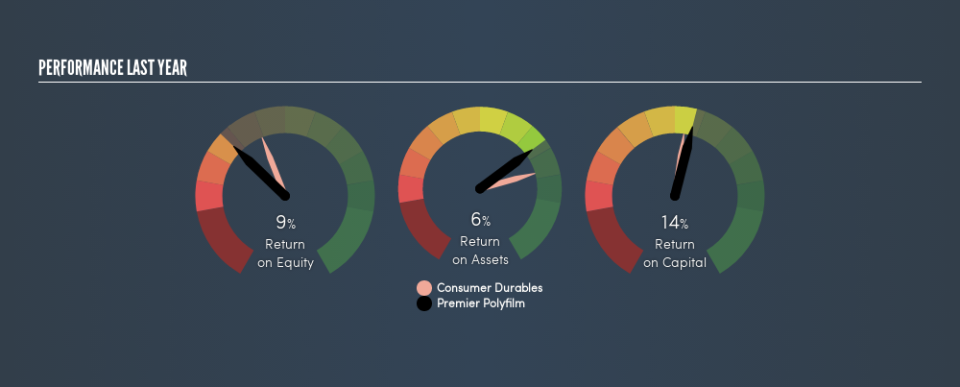Should Premier Polyfilm Ltd.’s (NSE:PREMIERPOL) Weak Investment Returns Worry You?

Today we are going to look at Premier Polyfilm Ltd. (NSE:PREMIERPOL) to see whether it might be an attractive investment prospect. Specifically, we’ll consider its Return On Capital Employed (ROCE), since that will give us an insight into how efficiently the business can generate profits from the capital it requires.
First of all, we’ll work out how to calculate ROCE. Next, we’ll compare it to others in its industry. Finally, we’ll look at how its current liabilities affect its ROCE.
Understanding Return On Capital Employed (ROCE)
ROCE is a metric for evaluating how much pre-tax income (in percentage terms) a company earns on the capital invested in its business. Generally speaking a higher ROCE is better. Overall, it is a valuable metric that has its flaws. Renowned investment researcher Michael Mauboussin has suggested that a high ROCE can indicate that ‘one dollar invested in the company generates value of more than one dollar’.
How Do You Calculate Return On Capital Employed?
Analysts use this formula to calculate return on capital employed:
Return on Capital Employed = Earnings Before Interest and Tax (EBIT) ÷ (Total Assets – Current Liabilities)
Or for Premier Polyfilm:
0.14 = ₹87m ÷ (₹881m – ₹401m) (Based on the trailing twelve months to December 2018.)
Therefore, Premier Polyfilm has an ROCE of 14%.
Check out our latest analysis for Premier Polyfilm
Does Premier Polyfilm Have A Good ROCE?
When making comparisons between similar businesses, investors may find ROCE useful. In this analysis, Premier Polyfilm’s ROCE appears meaningfully below the 17% average reported by the Consumer Durables industry. This performance is not ideal, as it suggests the company may not be deploying its capital as effectively as some competitors. Setting aside the industry comparison for now, Premier Polyfilm’s ROCE is mediocre in absolute terms, considering the risk of investing in stocks versus the safety of a bank account. It is possible that there are more rewarding investments out there.
When considering this metric, keep in mind that it is backwards looking, and not necessarily predictive. Companies in cyclical industries can be difficult to understand using ROCE, as returns typically look high during boom times, and low during busts. ROCE is, after all, simply a snap shot of a single year. If Premier Polyfilm is cyclical, it could make sense to check out this free graph of past earnings, revenue and cash flow.
Premier Polyfilm’s Current Liabilities And Their Impact On Its ROCE
Current liabilities are short term bills and invoices that need to be paid in 12 months or less. The ROCE equation subtracts current liabilities from capital employed, so a company with a lot of current liabilities appears to have less capital employed, and a higher ROCE than otherwise. To check the impact of this, we calculate if a company has high current liabilities relative to its total assets.
Premier Polyfilm has total liabilities of ₹401m and total assets of ₹881m. Therefore its current liabilities are equivalent to approximately 46% of its total assets. Premier Polyfilm’s middling level of current liabilities have the effect of boosting its ROCE a bit.
The Bottom Line On Premier Polyfilm’s ROCE
With this level of liabilities and a mediocre ROCE, there are potentially better investments out there. But note: Premier Polyfilm may not be the best stock to buy. So take a peek at this free list of interesting companies with strong recent earnings growth (and a P/E ratio below 20).
I will like Premier Polyfilm better if I see some big insider buys. While we wait, check out this free list of growing companies with considerable, recent, insider buying.
We aim to bring you long-term focused research analysis driven by fundamental data. Note that our analysis may not factor in the latest price-sensitive company announcements or qualitative material.
If you spot an error that warrants correction, please contact the editor at editorial-team@simplywallst.com. This article by Simply Wall St is general in nature. It does not constitute a recommendation to buy or sell any stock, and does not take account of your objectives, or your financial situation. Simply Wall St has no position in the stocks mentioned. Thank you for reading.

